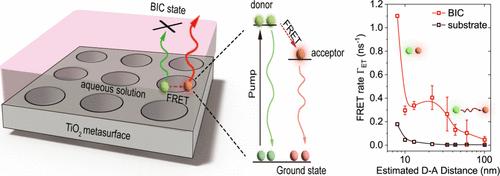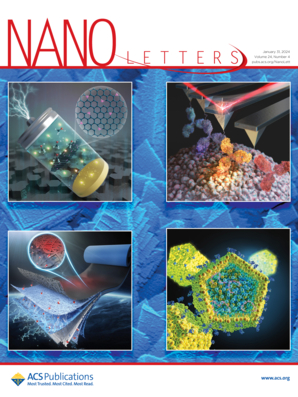通过连续体内的束缚态释放巨型福斯特共振能量转移
IF 9.6
1区 材料科学
Q1 CHEMISTRY, MULTIDISCIPLINARY
引用次数: 0
摘要
由偶极-偶极相互作用(DDI)驱动的佛斯特共振能量转移(FRET)被广泛应用于化学、生物和纳米光子学领域。然而,传统的 FRET 在供体-受体距离超过 10 纳米时效果不佳,而且测量信噪比较低。在本研究中,我们利用介电元表面空腔中的连续体束缚态(BIC)模式,证明了在环境条件下 FRET 的显著增强和相互作用距离的延长。这种增强是通过利用与 BIC 模式相关的超高品质因数、最小材料吸收和非局部效应实现的。光谱和角度分辨光致发光(PL)寿命测量显示,BIC 模式显著提高了 FRET 速率和相互作用距离。FRET 速率提高了多达 70 倍,相互作用距离显著提高了一个数量级以上,达到了 100 nm。这些发现为利用无损耗介质元表面实现长程、高效 FRET 和集体 DDI 提供了宝贵的启示。本文章由计算机程序翻译,如有差异,请以英文原文为准。

Unleashing Giant Förster Resonance Energy Transfer by Bound State in the Continuum
Förster resonance energy transfer (FRET), driven by dipole–dipole interactions (DDIs), is widely utilized in chemistry, biology, and nanophotonics. However, conventional FRET is ineffective at donor–acceptor distances exceeding 10 nm and measurements suffer from low signal-to-noise ratios. In this study, we demonstrate significant FRET enhancement and extended interaction distances under ambient conditions by utilizing a bound state in the continuum (BIC) mode within a dielectric metasurface cavity. This enhancement is achieved by leveraging the ultrahigh quality factors, minimal material absorption, and nonlocal effects associated with the BIC mode. Spectrally and angularly resolved photoluminescence (PL) lifetime measurements reveal that the BIC mode significantly increases the FRET rate and interaction distance. The FRET rate is enhanced by up to 70-fold, and the interaction distance is significantly boosted by over an order of magnitude, reaching ∼100 nm. These findings offer valuable insights for achieving long-range, high-efficiency FRET and collective DDIs using loss-less dielectric metasurfaces.
求助全文
通过发布文献求助,成功后即可免费获取论文全文。
去求助
来源期刊

Nano Letters
工程技术-材料科学:综合
CiteScore
16.80
自引率
2.80%
发文量
1182
审稿时长
1.4 months
期刊介绍:
Nano Letters serves as a dynamic platform for promptly disseminating original results in fundamental, applied, and emerging research across all facets of nanoscience and nanotechnology. A pivotal criterion for inclusion within Nano Letters is the convergence of at least two different areas or disciplines, ensuring a rich interdisciplinary scope. The journal is dedicated to fostering exploration in diverse areas, including:
- Experimental and theoretical findings on physical, chemical, and biological phenomena at the nanoscale
- Synthesis, characterization, and processing of organic, inorganic, polymer, and hybrid nanomaterials through physical, chemical, and biological methodologies
- Modeling and simulation of synthetic, assembly, and interaction processes
- Realization of integrated nanostructures and nano-engineered devices exhibiting advanced performance
- Applications of nanoscale materials in living and environmental systems
Nano Letters is committed to advancing and showcasing groundbreaking research that intersects various domains, fostering innovation and collaboration in the ever-evolving field of nanoscience and nanotechnology.
 求助内容:
求助内容: 应助结果提醒方式:
应助结果提醒方式:


